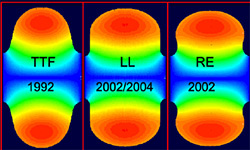Director's Corner
2 February 2006

Barry Barish
R&D Board
A decade or so ago, the thought of building a TeV scale linear collider was pretty much just a romantic notion. The long extrapolations from present accelerators and from proven technologies were daunting. But, mostly as a direct result of more than a decade of enormously successful and impressive R&D, we are now able to undertake a serious design effort toward such a machine. The basic technologies that will be needed in a linear collider have been demonstrated, especially the superconducting RF technology which will be the basis of the main linac.
This highly successful ILC R&D program continues to be primarily supported regionally by the major high energy physics laboratories throughout the world. Considering the successes of the program as it is presently being carried out, one might wonder whether or what role the GDE should assume in coordinating this R&D program? First, we need to recognize that the needs for R&D in the development of a linear collider design are far from finished. In fact, the continuing and future R&D programs will be absolutely crucial for demonstrating critical elements of the design, optimizing it with respect to cost and performance, and finally evolving it as technologies improve, so that we can build the best possible machine when the ILC is constructed.
To insure that the ILC R&D maximally supports our design efforts, the GDE must provide global guidance for the program, set priorities, justify overlaps and identify gaps in the program. For these reasons, I created an R&D Board at the Frascati GDE meeting in December. Previously in this column, I described the other two boards (Design Cost Board and a Change Control Board) that I appointed with missions related to guiding, reviewing and documenting our global design effort toward a reference design this calendar year.

TESLA Superconducting RF cavity shape (left)
and two alternate shapes under study in the ILC R&D program.
This third board is dedicated to our goal of reviewing, prioritizing and guiding the R&D program on a global basis. We want to make every effort to align the present and future R&D as closely as possible with the global design effort. This will involve prioritizing, avoiding duplication, covering missing areas, etc. The R&D Board is chaired by Bill Willis of Columbia University. The other members include: Hasan Padamsee (Cornell), Tom Himel (SLAC), Andy Wolski (LBNL), Hitoshi Hayano (KEK), Toshiyasu Higo (KEK), Eckardt Elson (DESY), Lutz Lilje (DESY) and Terry Garvey (LAL – IN2P3).
The stated the mission of our Global R&D Board as I presented at Frascati includes:
The Global R&D Board will be responsible for assessing and providing guidance for the overall R&D program. The RDB will suggest priorities for the research facilities and R&D supporting the baseline, the R&D on alternatives to the baseline and selective R&D that could further the field in the longer term. The mission will also include global assessments and recommended priorities for the detector R&D program and evaluate the balance between accelerator and detector R&D.
Bill Willis and colleagues have taken on this challenge and to quote Bill, "We plan to compare the ‘Proposals' (including programs of work funded and on-going as such) with an ‘Ideal R&D Program' best suited to the needs of the Baseline Design, and assign priorities accordingly."